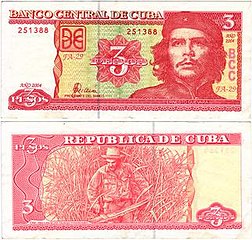Cuban peso
| Cuban peso | |
|---|---|
| peso cubano (Spanish) | |

A 3 peso banknote depicting Che Guevara
|
|
| ISO 4217 | |
| Code | CUP |
| Denominations | |
| Subunit | |
| 1/100 | centavo |
| Symbol | $, $MN, or ₱ |
| centavo | ¢ or c |
| Banknotes | |
| Freq. used | $1, $3, $5, $10, $20, $50, $100, $200, $500 |
| Rarely used | $1,000 |
| Coins | |
| Freq. used | 20¢, $1, $3 |
| Rarely used | 1¢, 5¢ |
| Demographics | |
| User(s) |
|
| Issuance | |
| Central bank | Central Bank of Cuba |
| Website | www |
The peso (ISO 4217 code: CUP, sometimes called the "national currency" or in Spanish moneda nacional) is one of two official currencies in use in Cuba, the other being the convertible peso (ISO 4217 code: CUC, occasionally called "dollar" in the spoken language). There are currently 25 CUP per CUC.
Most Cuban state workers receive their wages in national pesos, but some receive a portion of their salary in convertible pesos. Shops that sell basics like fruit and vegetables generally accept only the normal peso. "Dollar shops" sell the rest. The word "pesos" may refer to both types of money.
Cuban convertible pesos are 25 times more valuable, but that does not completely eliminate the confusion for tourists. Since goods bought in national pesos have government-controlled prices, tourists are sometimes confused by prices that look "too cheap." The hard (CUC) pesos are easy to tell apart from the national (CUP) ones, as CUC coins have an octagonal shape within the outer round rim. The only exception to this is the most common CUP coin, the 1 peso, also has this octagonal shape. Also, CUC currency shows monuments, and CUP bills have portraits.
Before 1857, Spanish and Spanish colonial reales circulated in Cuba. From 1857, banknotes were issued specifically for use on Cuba. These were denominated in pesos, with each peso worth 8 reales. From 1869, notes were also issued denominated in centavos, with 100 centavos worth each peso. In 1881, the peso was pegged to the US dollar at par. The currency continued to be issued only in paper form until 1915, when the first coins were issued.
In 1960, the peg to the dollar was replaced by one to the Soviet ruble. The peso lost value by the United States embargo against Cuba and the suspension of the sugar quota. The suspension was the principal economic force driving Cuba to seek out a new economic partner, the Soviet Union. When the Soviet Union dissolved in 1991, the peso lost much of its value and the exchange rate fell to 125 pesos to the US dollar. Recently, it has become more valuable and fluctuated between 23 and 25 pesos to the US dollar.
...
Wikipedia
